Pandanus and its cultivation
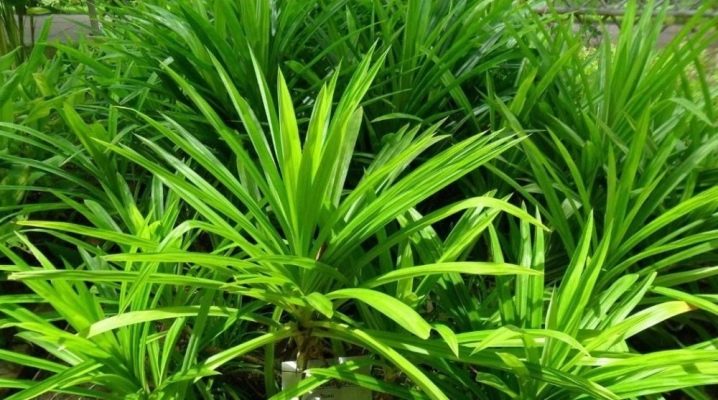
The pandanus and its cultivation is the subject of much debate over its suitability for domestic breeding. The exotic representative of the pandanov family is only one of more than 7 hundred species, of which about 100 are found in Madagascar. Pandanus in the wild can be found anywhere - from the crater wall of an extinct volcano to the sea coast. A person uses the plant for various needs - from traditional medicine and witchcraft rituals to weaving from leaf veins, eating fruits and as an ornamental plant.
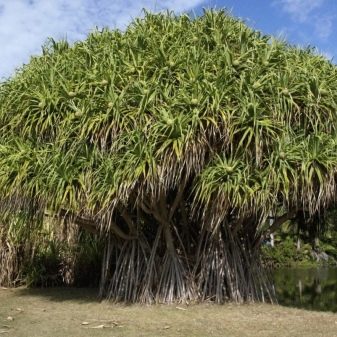
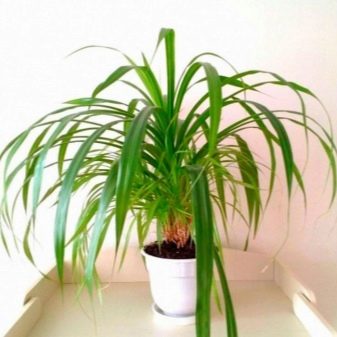
general description
Pandanus, the beauty of which attracts many flower growers, is fanned by various and not always reliable statements. You can see the information that it is suitable only for Capricorns, the spiral shape spreads heavy energy throughout the room, brings misfortune and illness. There are also statements that one should not be afraid of it as a houseplant. A correctly chosen place minimizes bad energy, helps the owner to tune and improve the activity of the mind.
The flower is extremely decorative, easy to take root and undemanding to care for. The debate about whether it can be kept at home is not scientific and is based on strange prejudices, they are in relation to many ornamental crops intended for breeding in an apartment or house. But the spiral palm does not deserve such treatment.
For many centuries it has faithfully served human needs, participates in religious rituals, feeds, cleans and heals teeth, is used in weaving, medicine, and helps feed animals.
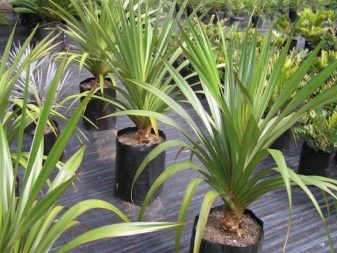
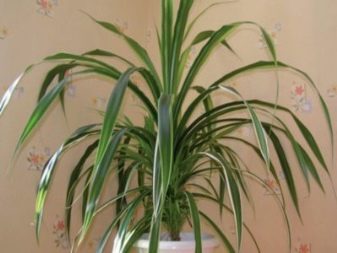
Pandanus is the name used by the naturalist Bory de Saint-Vincent, who made the first description, and it comes from Indonesia.
The representatives of the family can be distinguished by the bizarre arrangement of the leaves: they grow in a spiral. Hence the common unscientific name - spiral palm, and many statements, prejudices and legends about this amazing plant. Here are just a few:
- the growth of a tree can reach a height of 25 m, but at home it rarely grows to one and a half meters;
- people who are ignorant of botany may call it dracaena, palm tree or even pine, but pandanus has nothing to do with them, except for associations in appearance;
- in the wild, nature has provided for adventitious roots located on the trunk and acting as a natural anchor in conditions of complex growth - on slopes, with hurricane winds;
- the roots have another interesting feature - they lignify and harden in the soil if the powerful trunk dies off with age;
- the leaves describe variably, but there is no contradiction in this, their shape is determined by the species, they are mainly lanceolate, with needles on the frontal surface;
- flowering occurs in the form of an ear or panicle, there is no perianth in the inflorescences;
- the fruit in some species is edible, has a peculiar taste, but ripens only in nature, this does not happen at home, and it all depends on which species is chosen for cultivation.
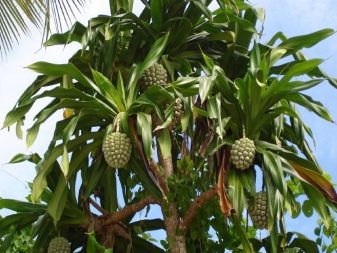
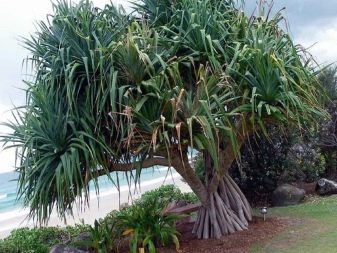
The advice of experts invariably contains references to the fact that growing a spiral palm tree, no matter how attractive it may seem to an amateur florist, is necessary only in spacious rooms with high ceilings.Now many houses and apartments are being built with improved living conditions, with a spacious layout, so it is not surprising that the pandanus migrates from halls and offices in public buildings to living quarters.
In a small size, he will feel cramped and will grow poorly, and the owner will write off this for care errors. In temperate climates, it will not be possible to use the plant as in its natural habitat. At home, in warm climates, it is a common decorative element of landscape design. You should not grow it even if there is a baby in the house who finds it difficult to explain that the plant should not be touched by the leaves.

Types and varieties
Despite the abundance of species in the wild habitat, only adapted varieties are used in home breeding, which have certain characteristics (decorativeness, relative safety, the ability not to grow to gigantic sizes). Not all of them can be found on the free sale, but in this case there are virtual stores that work for delivery.
- Roofing pandanus - a perennial green plant, reaching one and a half meters in height. He got the name for the green leathery leaves, which in places of growth are used to cover huts instead of roofs. At home, it is widely used for utilitarian purposes. It is used to make sails in small boats, weaving ropes, hats and baskets. The house makes a spectacular impression with long, up to a meter, dominant green leaves, reaching almost 10 cm in width.
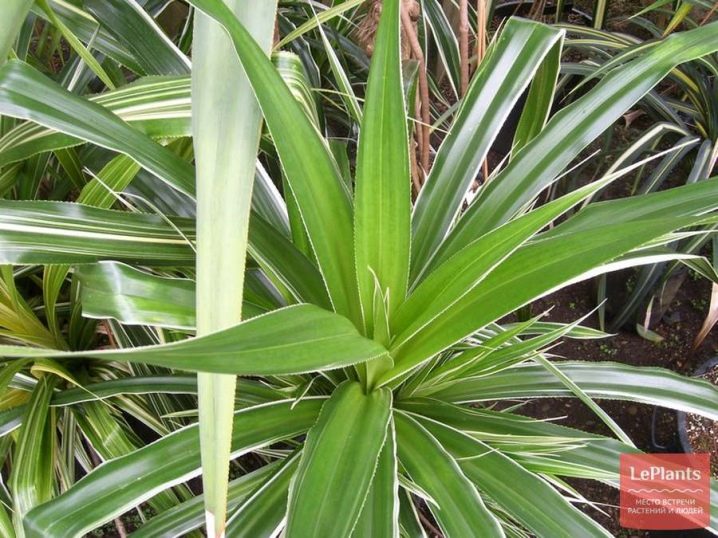
It is almost impossible to achieve flowering indoors.
- Veitch - variegated picturesque perennial, capable of growing up to 2 meters in height, with a short trunk and aerial roots. Leaves are the main reason that made the appearance a priority in indoor floriculture: a wide bottle-green surface at the edges is covered with contrasting longitudinal stripes, cream or snow-white.
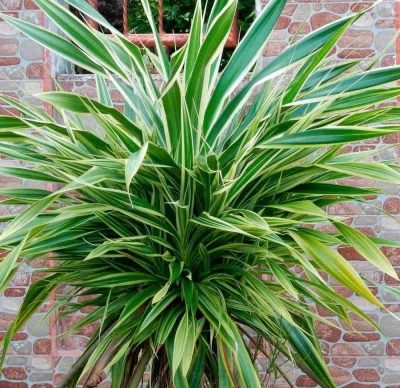
- Pandanus variegated - name of any kind with variegated leaves. The term is a tracing paper from the English word, which means “multi-colored” or “spotted”.
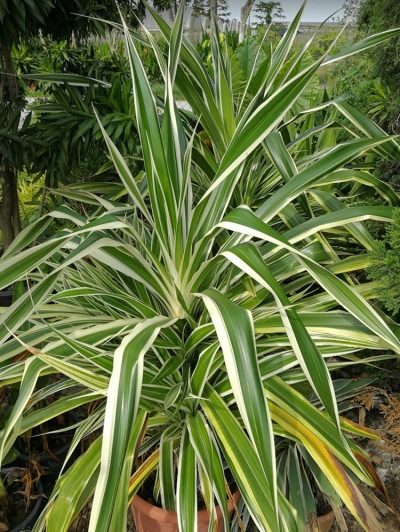
- Sander - also variegated, with narrow longitudinal stripes of a light yellow hue along green leaf plates, reaching a width of 5 cm, and growing up to 80 cm in length.
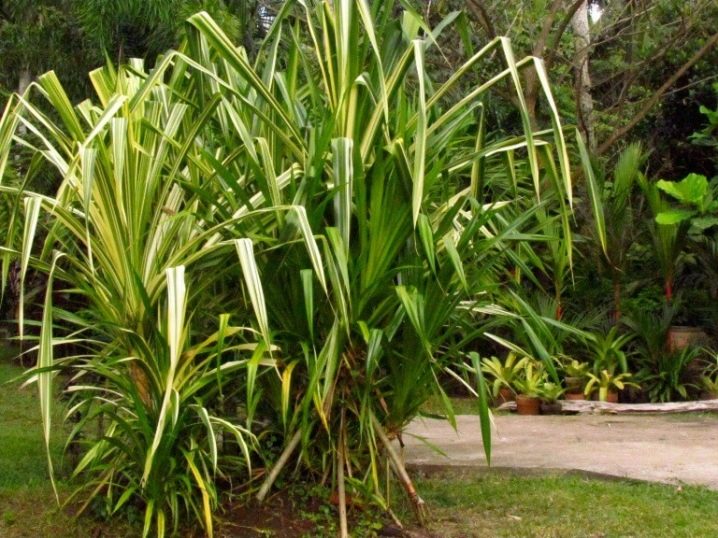
- Baptista - a two-meter perennial with leaves that are leathery to the touch.
Unlike other species, it has no denticles at the edges, the green leaf plate is decorated with nature: there are spectacular yellow stripes on it.
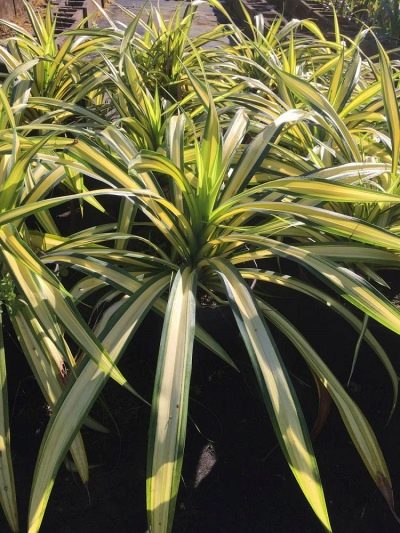
- Useful, highest, up to 3 m, with helical leaves on the trunk, reaching one and a half meters. In indoor floriculture, it is a rare guest because of its size. It is used in the decoration of public buildings, cafes and restaurants. It can be seen in closed train stations, in large shops or arcades. Long leaves with serrated edges are monochrome, emerald green.

The tree plant makes a stunning impression, it can be an independent detail in a spacious room or organically fit into the setting (with a seating area, twin armchairs, a leather sofa). Looks great in a public building, in the lobby of a residential building, in a glazed greenhouse or conservatory.
This is the main reason why the plant has become a fashionable trend in interior design, despite the spread of stories about energy, attracting disease and other properties that are unfoundedly attributed to the plant.
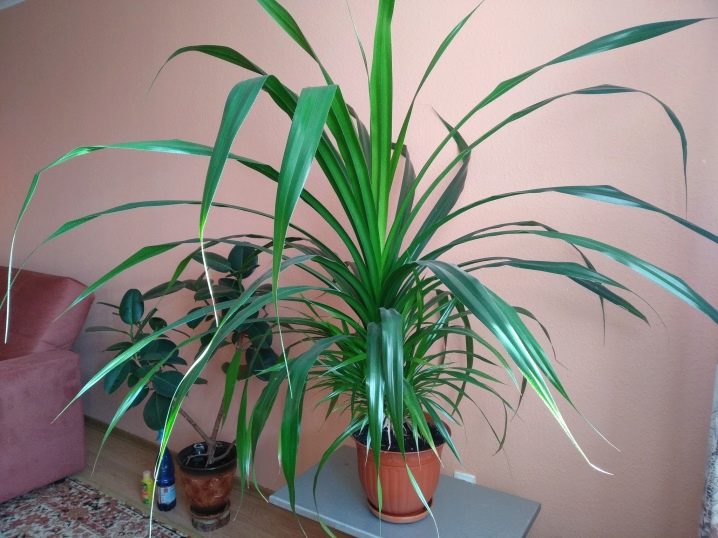
Landing
For this purpose, you can use wooden tubs, ceramic or clay pots. Young plants are often planted in plastic containers. Before pouring the soil, check if there is a hole for the drainage of excess moisture; drainage is laid on the bottom of the vessel. The larger the container for disembarkation, the more sizeable fractions are used.You can take purchased soil for palm trees or prepare a soil mixture yourself from greenhouse and clay soil, sand with coarse grains and peat. The second recipe is turf and leafy soil, humus and river sand.
The plant is placed in the center of the pot, evenly distributing the soil on all sides. After filling the pot, it is necessary to make a spill to compact the soil, after a while the excess water is carefully drained from the pan.
You need to use protective equipment so as not to scratch your hands with leaves.

Care
You won't have to look after the pandanus especially. But for its development, effective appearance and well-being at home, you will have to take care of the postulates that are important in the cultivation of any plant. We are talking about feeding, water, lighting and temperature, periodic replanting (this does not apply to those growing in tubs, but there you will have to change the upper soil layer) and reproduction, if necessary.
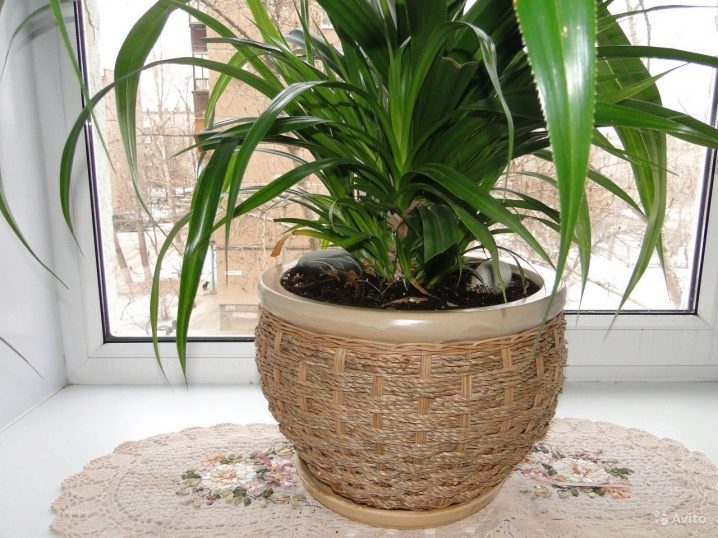
Consider the main nuances of care.
- Watering. It will not cause much trouble - it is performed once every one and a half weeks, certainly under the root, with warm, settled water. It will be necessary to expand irrigation measures in spring and summer. But even in this case, the main thing is not to overdo it and prevent liquid from getting into the axils of the leaves. Watering through the pallet is possible, but after an hour you need to pour out the excess so that the roots do not rot.
- Top dressing. After the transplant, it is carried out no earlier than 10 days. In early spring, fertilizer for deciduous plants with nitrogen is applied. They are bred in the indicated proportion and carefully applied to the soil layer. Granular can be mixed in a small amount with the soil, then they will gradually dissolve with each watering of the plant.
- Pruning. When pruning, the stem roots or processes formed at the trunk must not be destroyed under any circumstances. Only dried or yellowed leaves can be trimmed, either whole or at the edges.
- Transfer. This process is only done with young plants. With each movement, a container is applied larger than the previous one. The rest of the rules are the same as for planting - drainage, soil mixture. In order not to damage the leaves, they are carefully tied in a bundle and covered with a cloth bag.

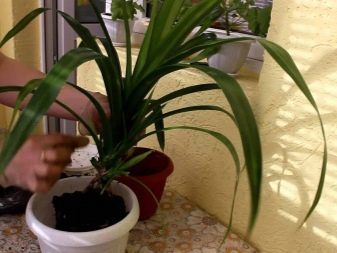
Reproduction
To increase the number of pets, you do not have to go shopping at a nursery or flower shop. Pandanus can be propagated in several ways:
- shoots separated from the trunk along with aerial roots (they do not appear in all species and require skill and care when cutting);
- cuttings, which are cut from the side branches, planted in the ground and covered with a transparent film on top;
- seeds (if you can get them), observing the conditions specified in the instructions;
- division (rosettes with roots are cut from the bush, they are dried and planted in moist soil).
All methods, except for grafting, are quite troublesome, require compliance with the temperature regime and knowledge of some nuances (for example, when dividing, lower heating is required for planting).
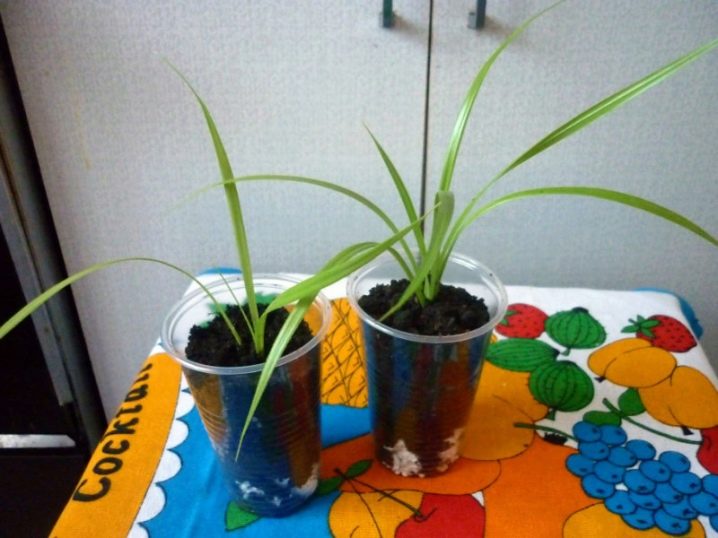
Diseases and pests
There can be several reasons for the disease: foliage turns yellow or turns pale from excessive lighting, the presence of an excess amount of calcium in the soil, water of great hardness. A mealybug, spider mite and scale insect may appear on the palm tree. In the first case, you will have to change the conditions, in the second - to use special drugs. Plant health should be monitored continuously and action should be taken as soon as a problem is detected.
Pandanus does not require much maintenance. This is a plant that is used both for decorative purposes and in folk medicine.
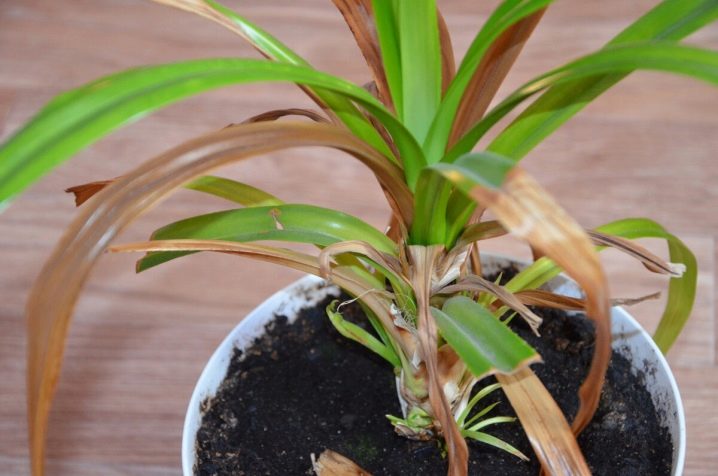













The comment was sent successfully.